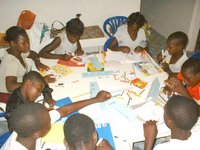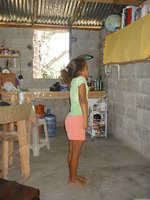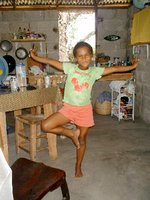In the session with Haitian kids the other Friday, we were learning, “How was your day?”to be accompanied by: excellent; very good; good; so, so; not bad; not good; bad.
“How was your day?”
“Bad.” One boy responded.
“Why? What happened?” I asked spontaneously in mixed Spanish and Creole.
The boy said, shyly, that his day was bad because he did not have shoes to go to school that morning. Later on, I gave my eyes to his thin legs under the table. He had worn-out vinyl sandals that were too large for his feet. It was perhaps something improvised for him to cross the river and sell things in the Dajabon market. And his mother (if he had) wouldn't dare to let him go to school with those sandals, I imagined.
It seems that many Haitians (as well as Dominicans) view schools as a special, exclusive place where you have to go with a nice set of clothes, hair, shoes and well-bathed clean body. When I was small, it was more important not to miss any class than going with neatly tied hair (i.e., I had been to school with messy hair). The conditions of Japan 20 years ago and the current Caribbean cannot be compared on the same basis. But if there are many children who cannot go to school due to the lack of (the quailty of) their clothes--uniform which are often donated--, shoes or bags, it's because schools are interpreted more for its physical characteristics ("looks") than its original objective of "learning." Foreigners would find the Dominican and Haitian classrooms pleasantly filled with neat, clean children. But without looking into the gap between those neat children and those "unneat" children that are out of school, the arguments over school improvement or educational development don't really have their foundation.
ハイチ少年(4) 
ハイチの子どもたちとのセッションで、先週の金曜日は、英語で「今日はどんな日だった?」という言いまわしを学んだ。答えは、excellent; very good; good; so, so; not bad; not good; bad から選んでもらう。順番に一人づつに聞いていった。
ある男の子から「Bad」という答えがかえってきたので、「どうして?何があったの?」とスペイン語とクレオール語を混ぜて聞き返してしまった。男の子は、「今朝、靴がなくて学校に行けなかったから」と、小さな声で言った。後で気づかれぬようにテーブルの下の彼の細い足に目をやると、ボロボロでぶかぶかのビニールサンダルを履いていた。おそらく、川を渡ってダハボンのマーケットでモノを売るために間に合わせたものだろう。そして、彼の母親(がいるとすれば)は、あのビニールサンダルで自分の息子を学校にやることはしないだろう、と想像した。
ハイチでもドミニカ共和国でも、学校は特別の場所で、ちゃんとお風呂に入って、身なりを整えてからでないと行けない、というような認識があるようだ。私が小学生のころは、きちんと髪を結わうよりも学校に遅刻しないことの方が優先だったのだが。スクールバスに乗り遅れそうでぼさぼさ髪で家を出たことはよくあったし、「お風呂に入ってないから学校に行っちゃだめ」など言われたことはなかった。勿論20年前の日本と現在のカリブとでは状況も度合いも違う。しかし、靴やかばんや洋服(奨学金で与えられることが多い制服)ゆえに学校に行けない子どもたちが多くいるとすれば、それは学校に対する認識や理解が本来のものから「かたち」よりになってしまっているからだろう。ハイチやドミニカで小学校を覗かせてもらうと、児童のきちんとした身だしなみに感心する外国人が多いだろうが、そこからはみ出ている子どもたちとのギャップに注目しなければ、学校改善、教育開発の話は始まらない。




